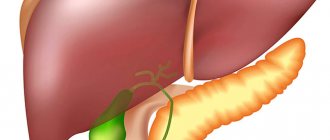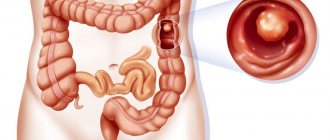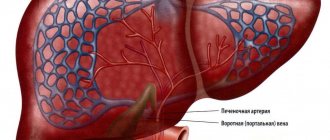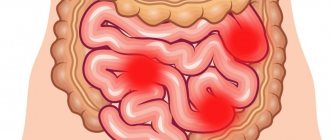The colon makes up approximately 4/5 of the total length of the large intestine. It has four sections: the ascending, transverse, descending and sigmoid colon. The latter passes into the rectum.
Colon cancer is one of the most common cancers. This pathology is usually referred to as “colon cancer.” Tumors of the colon and rectum are combined into one group of oncological diseases and are called colorectal cancer.
Typically, the appearance of a malignant tumor of the colon is preceded by the appearance of a benign neoplasm - a polyp. There are different types of polyps, and they have different potential for malignancy. The risks increase with age, so everyone 50 years of age and older is recommended to undergo a screening endoscopic examination - a colonoscopy.
Depending on the anatomical part of the tumor, cancer is classified into the transverse colon, ascending and descending colon, and sigmoid colon.
- Causes of colon cancer development
- Classification
- Stages of Colon Cancer
- How does cancer metastasize from the colon?
- Symptoms
- Complications of colon cancer
- Diagnostic methods
- Treatment methods
- Forecast
Causes of colon cancer development
It is impossible to say exactly why a particular person developed a malignant tumor in the colon. Cancer is always the result of a specific set of mutations in a cell, but what led to these mutations is a difficult question to answer.
There are some risk factors that increase the likelihood of developing colorectal cancer:
- Age. The risk of getting sick increases after 50 years. Apparently, this is due to the fact that over time, more and more genetic defects accumulate in the cells of the human body.
- Heredity. If your close relatives (parents, sisters, brothers, children) have been diagnosed with colon cancer, your risk is also increased.
- Unhealthy eating. The development of cancer is promoted by a “Western” diet, which contains a lot of red and processed meat, fast food, processed foods, and little fruits, vegetables and fiber. There are especially many carcinogens in food prepared by frying, grilling, or barbecuing.
- Low physical activity. People who lead a sedentary lifestyle are at increased risk.
- Excess weight. People who are overweight or obese are more likely to get colon cancer and have a worse prognosis.
- Smoking. The development of malignant tumors in the intestines is promoted by smoking and excessive alcohol consumption.
- Hereditary diseases. Parents can pass on certain mutations to their children that make them more susceptible to developing cancer. The most common hereditary diseases from this group are Lynch syndrome, as well as familial adenomatous polyposis.
- Chronic inflammation of the colon : ulcerative colitis, Crohn's disease.
None of these factors are 100% likely to cause colon cancer. Each of them only increases the risks to a certain extent. Some of these factors can be influenced, for example, start eating right, giving up alcohol and cigarettes, and playing sports.
Other factors, such as heredity, inflammatory bowel diseases, age, cannot be influenced. You need to be aware of your risks and get checked regularly. You can undergo screening using modern equipment at the European Clinic.
Book a consultation 24 hours a day
+7+78
Causes of malignant tumor
There are enough reasons for cancer to fall into the risk category. Among the common ones are overweight, unhealthy diet, environment, harmful production and heredity (and of a similar nature). If brothers or sisters or parents have been exposed to the disease, there is a high probability of cancer developing in a person.
Those who like to use different diets should carefully select their diet. Those who prefer snacks are encouraged to remove excess fats, replacing them with fiber or other plant foods rich in vitamins. Animal fat in any form increases the production of bile, which changes the structure of the walls of the large intestine. Also, the breakdown of fats and the subsequent formation of peroxidases directionally increases the percentage of cancer.
Malnutrition negatively affects the functioning of the intestines: a lack of fiber changes the process of breaking down food, and the resulting carcinogens destroy the intestinal walls. Such formations are not removed from the body. Vitamins and minerals are vital for people. The lack of the latter leads to the degeneration of healthy cells into mutating ones, creating the danger of organ damage.
If a person does not like to move or leads a sedentary lifestyle by profession, there remains a risk of not only obesity, but also cancer. Inactivity leads to constipation, stagnation, which leads to deformation of the organ due to the accumulation of feces.
Diseases that provoke the formation of cancer cells are known: nonspecific ulcerative colitis, Peutz-Jeghers syndrome, Crohn's disease, Turcot syndrome and others.
Age affects the condition of the body. Cancer patients are usually over 50 years of age.
Working in hazardous industries lowers the immune system, and exposure to chemicals, mining, and sawmilling expose workers to the risk of ending up in a hospital bed.
Classification
The most common type of colon cancer and colorectal cancer in general is adenocarcinoma . It develops from glandular cells that are found in the mucous membrane. Adenocarcinomas represent more than 96% of malignant neoplasms of the colon. In this group of tumors, a number of subgroups are distinguished. The most aggressive of them are mucinous and signet ring cell carcinoma .
Such patients have the most unfavorable prognosis.
Prognosis (survival) at different stages
The outcome of the disease is determined by pathomorphological criteria, localization and prevalence of the malignant process, and a number of other equally important factors. Let's look at how the 5-year survival rate of patients with colon adenocarcinoma is predicted:
- tumors limited to the intestinal wall (stage I-II) - 80%;
- neoplasms that have grown through the wall of the organ, but have not affected the regional lymph nodes - 60%;
- oncological process characterized by involvement of the lymphatic system - 30%;
- metastases in the liver and lungs (stage IV) - the life expectancy of patients does not exceed 6-8 months;
- well-differentiated adenocarcinoma - the prognosis will always be favorable compared to undifferentiated tumors.
Survival rate is also affected by a person’s age: among older patients, surgical mortality is higher, but in young patients, rapidly progressing malignant neoplasms predominate. In addition, the prognosis is always worse in men and in the case of the development of complications of the disease - intestinal obstruction, perforation, peritonitis, etc.
Stages of Colon Cancer
Colon cancer is classified into stages depending on the size and depth of the primary tumor (T), the presence of foci in regional lymph nodes (N) and distant metastases (M). There are five main stages:
- Stage 0 - “cancer in situ.” A small tumor that is located within the mucous membrane does not grow deeper.
- Stage I is a tumor that has grown into the submucosa or muscle layer of the intestinal wall.
- Stage II - a tumor that has grown into the deep layers of the colon wall (IIA), has grown through it and spread to neighboring organs (IIB), or there is a small tumor, as in stage I, and foci in 1-3 nearby lymph nodes (IIIC ).
- Stage III is divided into three substages: IIIA, IIIB and IIIC, depending on how deep the tumor has grown into the intestinal wall and how many lymph nodes are involved.
- Stage IV : There is metastasis in one organ (such as the liver or lungs) or in a group of lymph nodes that is far from the bowel (IVA), or there are metastases in more than one organ or group of lymph nodes (IVB), or the cancer has spread over the surface peritoneum (IVC). In this case, the size of the primary neoplasm and how deeply it has grown into the wall of the colon are not important.
Types, types, forms
Depending on the Gleason grade of the cells, colon adenocarcinoma can be:
- highly differentiated;
- moderately differentiated;
- poorly differentiated;
- undifferentiated.
Each of these forms differs in the rate of growth and spread beyond the affected organ. The treatment and prognosis of the existing disease depend on these factors. Let's talk about them in more detail.
Well-differentiated adenocarcinoma. Least dangerous when compared with other forms of Gleason differentiation. The tumor contains a minimum of atypical cells, which are not deprived of their functionality and differ slightly from healthy structures. Thus, the neoplasm has a low degree of malignancy. It does not spread metastases and with timely treatment, the prognosis for survival will be favorable.
Moderately differentiated adenocarcinoma. It has a more complex flow compared to the previous version. Tumor cells grow throughout the large intestine, causing partial and sometimes complete obstruction. Without treatment at this stage, the neoplasm quickly degenerates into a poorly differentiated form with a high degree of aggression.
Poorly differentiated colon adenocarcinoma. Diagnosed in 20% of cases. The tumor grows rapidly and metastasizes to neighboring tissues and organs, so the oncological process is detected in the early stages of the disease. Neoplasms with a low degree of differentiation do not have clear boundaries, which complicates their removal. In 90% of cases, such tumors are considered unresectable, so the oncological process cannot be completely cured and patients are prescribed palliative care measures.
Undifferentiated adenocarcinoma. Does not have any common characteristics with healthy tissues. When performing histology, it is impossible to determine the origin of the tumor. The neoplasm is characterized by rapid infiltrative growth into the abdominal cavity and early metastases. The prognosis for patients with an undifferentiated tumor is negative.
Based on morphological characteristics, adenocarcinomas of the large intestine are classified into the following types:
- Tubular tumor. It is characterized by long-term asymptomatic progression or mild clinical manifestations. The neoplasm consists of tubular cellular structures. In this regard, the diagnosis of the disease is delayed, and the oncological process is detected at later stages. In some cases, pathology may be discovered accidentally during routine radiography. Tubular adenocarcinoma of the colon is difficult to treat and the prognosis is poor.
- Mucinous (mucus-forming) tumor. Rarely encountered, the neoplasm develops from cystic cellular structures that actively produce mucus. The tumor lesion can grow to impressive sizes. The oncological process is characterized by early spread of metastases and frequent relapses.
- Signet ring cell tumor. It has a high degree of malignancy. Patients who consult a doctor with such adenocarcinoma, even in the early stages, already have metastatic changes in regional lymph nodes and in the liver. This tumor is characterized by growing inside the wall of the large intestine and quickly closing its lumen. Signet ring cell adenocarcinomas are usually diagnosed in young and middle-aged patients.
- Squamous cell tumor. As a rule, it is localized in the area of the rectum and anus. Like the previous form, it is characterized by a high degree of aggressiveness, early metastases and frequent relapses, and therefore the prognosis for survival for patients will be extremely low. The neoplasm quickly leaves the primary cancer focus and grows into the vaginal walls, prostate gland, ureters and bladder.
- Dark cell tumor. Rarely encountered, neoplasms of this type affect the abdominal organs. During histological examination, adenocarcinoma cells are stained dark because they are excessively sensitive to pigment. Basically, dark cell adenocarcinomas belong to tumors of a high degree of differentiation.
How does cancer metastasize from the colon?
Colon cancer can spread to other organs in different ways:
- The implantation route is when cancer cells penetrate into neighboring organs that are in contact with the intestine and “spread” over the surface of the peritoneum.
- Some cancer cells break away from the primary tumor, enter the blood or lymph vessels, and migrate through them to the lymph nodes or other organs. Such routes of metastasis are called hematogenous and lymphogenous .
Most often, metastases from colon cancer are found in the lungs and liver, less often in the bones and brain.
Recovery process after treatment
Rehabilitation after radical treatment of glandular colon cancer is a long and complex process. At this stage, you must strictly follow all the specialist’s recommendations. These include the mandatory wearing of a bandage to reduce excess intra-abdominal pressure and quickly restore the muscle corset and wounds. It is not advisable to lie down for a long time after surgery. Patients can get up on the 5th day, move independently to the toilet, go for procedures in the dressing and manipulation rooms.
Important attention is paid to proper nutrition. The diet in the first weeks after colon surgery should consist of herbal teas, low-fat broths, liquid cereals, fermented milk products and baby food. You should forget for a while about vegetables, fruits, meat, canned food and other foods that cause heaviness in the stomach and fermentation processes in the lower gastrointestinal tract.
During the recovery period, the patient may experience bowel problems such as diarrhea. This is quite natural; diarrhea is a sign that intestinal function is returning to normal. If the patient has a colostomy, it is necessary to use and frequently change a colostomy bag into which feces are collected.
Postoperative monitoring of the patient is considered one of the main factors in monitoring the restoration of internal organs; it helps to prevent and promptly notice possible complications, which are not uncommon after abdominal surgery. Diagnostics should be performed quarterly and include the following:
- medical examination;
- endoscopic examination of the colon - colonoscopy;
- Ultrasound of the abdominal cavity;
- rectal examination of the anus.
Once every six months, it is recommended to donate blood for tumor markers - CEA and CYFRA, and also do fluorography of the lungs, since tumor metastases are quite often found in this area. If any questionable symptoms appear that indicate a possible resumption of the oncological process, it is necessary to be fully examined using MRI or CT.
Symptoms
Colon cancer often exists for a long time without causing any symptoms. But even when symptoms do occur, they are nonspecific and resemble those of many other diseases. If you are experiencing problems from this list, most likely you do not have cancer, but you should definitely visit a doctor and get tested:
- constipation or diarrhea that lasts for several days;
- change in the appearance of the stool: if it becomes dark, like tar, or thin, like a pencil;
- blood in the stool;
- after visiting the toilet there is a feeling that the intestines have not been completely emptied;
- pain, abdominal cramps;
- causeless weakness, feeling tired, unexplained weight loss.
Prevention
Unfortunately, there are currently no specific measures that could prevent colon adenocarcinoma. But the following factors will help reduce the likelihood of developing the disease:
- balanced diet;
- timely and competent treatment of any pathologies of the gastrointestinal tract, in particular of an infectious-inflammatory nature;
- avoiding stress;
- active lifestyle;
- regular visits to a gastroenterologist and proctologist by people who are at risk for the disease.
People who have had colon adenocarcinoma resection in the past should visit their doctor at least once every 3-6 months. This will help to detect a possible relapse of the cancer process in time and undergo the necessary treatment.
Are you interested in modern treatment in Israel? Thank you for taking the time to complete the survey. Everyone's opinion is important to us.
Complications of colon cancer
If the tumor blocks the lumen of the colon, the patient develops intestinal obstruction . This condition manifests itself in the form of lack of stool, severe abdominal pain, nausea, vomiting, and severe deterioration in general condition. The patient immediately requires medical attention, otherwise necrosis (death) of a section of the intestine may occur and peritonitis will develop.
If the tumor leads to constant bleeding, anemia develops. The patient becomes pale, constantly experiences weakness, and is bothered by headaches and dizziness. In severe cases, a blood transfusion is required.
Metastasis of intestinal cancer to the liver threatens to disrupt the outflow of bile and develop obstructive jaundice - a condition in which the skin and mucous membranes acquire a yellowish tint, itching, abdominal pain, and general condition worsen. Until the flow of bile is restored, it becomes impossible to carry out active antitumor treatment.
A condition in which cancer cells spread over the surface of the peritoneum is called carcinomatosis , and ascites , an accumulation of fluid in the abdomen. This complication develops in stage IVC colon cancer. Ascites worsens the patient's condition, complicates treatment and has a sharply negative impact on the prognosis.
The European clinic has everything necessary to effectively combat complications of malignant tumors of the colon. In case of emergency, patients receive full treatment in the intensive care unit. Our surgeons perform palliative operations and install stents for intestinal obstruction. For obstructive jaundice, we perform drainage and stenting of the biliary tract. For ascites, our doctors perform laparocentesis (evacuation of fluid through a puncture), install peritoneal catheters, and conduct systemic and intraperitoneal chemotherapy.
For stage IVC colon cancer, when peritoneal carcinomatosis develops, surgeons at the European Clinic use an innovative treatment method - hyperthermic intraperitoneal chemotherapy (HIPEC). All large tumors are removed, then the abdominal cavity is washed with a chemotherapy solution heated to a certain temperature - this helps to destroy small lesions. According to the results of world practice, HIPEC can prolong the life of a cancer patient up to several years.
Book a consultation 24 hours a day
+7+78
Prognosis for cancer patients
The pathology is common among all oncological lesions of the intestine. Has symptoms characteristic of the entire colon.
- Painful discomfort in the damaged area. Patients note dull or sharp pain above the navel, which increases a couple of hours after eating.
- Asthenovegetative manifestations.
- Alternating constipation and diarrhea.
- Vomiting food eaten the day before.
- Nausea.
- Formation of difficulty in passing a bolus of food through the intestines.
- Heartburn.
- Bloating, increased gas formation.
- Persistent fever.
The prognosis for the disease is associated with early diagnosis. The earlier the disease is detected, the greater the chances of a favorable outcome. With complete resection of the transverse section, the survival rate is 75%.
The prognosis for patients after colon cancer surgery is favorable. Statistics indicate that death was recorded in only 8% of cancer patients. However, we should not forget that timely consultation with a doctor and a quick and correct diagnosis are important.
Patients who seek help at the first stage have almost 100% survival rate in the first 5 years. The second stage of cancer indicates a survival rate of 70%, and the third indicates only 30% of those who will be able to prolong their life with an advanced disease.
Ascending colon or transverse colon cancer saves the lives of all patients. Almost 95% remain without recorded relapses of the disease.
The affected descending colon also shows high percentages that guarantee the life of the patient.
With more serious lesions, survival rate declines sharply. An advanced form of cancer is fatal. Therefore, it is important to conduct preventive examinations, lead a healthy lifestyle, and monitor for the slightest manifestations of suspicious symptoms. Any signs should be discussed in the doctor's office.
Diagnostic methods
If a patient is concerned about symptoms that may indicate colon cancer, the doctor will first order an abdominal ultrasound and colonoscopy. These studies will help detect a tumor, and during a colonoscopy you can perform a biopsy - obtain a fragment of pathologically altered tissue and send it to the laboratory. A biopsy is the most accurate method for diagnosing cancer.
Colonoscopy is an effective screening method. It helps detect polyps and colon cancer in the early stages. It is recommended for all people over 50 years of age. At the European Clinic, colonoscopies are performed by expert doctors using the latest equipment from leading manufacturers. Our procedure takes place in a state of “medicated sleep,” so you will not experience any discomfort.
Once cancer is diagnosed, its stage must be determined. For this purpose, CT, MRI, and PET scans are used. Metastases in the lungs are detected using chest x-ray. If there are metastases in the liver, angiography is used - an X-ray examination, during which a contrast solution is injected into the blood vessels.
Additionally, the doctor may prescribe a stool test for occult blood, a general and biochemical blood test to detect anemia, and evaluate liver function. Blood tests for tumor markers are usually performed during treatment to monitor its effectiveness.
Differential diagnosis
The symptoms that occur with colon cancer can be disturbing in many other pathologies. Most often, a malignant tumor must be differentiated from diseases such as intestinal infections, chronic inflammatory processes, hemorrhoids, and irritable bowel syndrome.
Symptoms
Symptoms do not depend solely on the disease, but are associated with the location, stage and type of tumor. The onset of the disease is hidden. The pathology occurs without symptoms. Diagnosis at an early stage is considered a miracle; such stages are detected during preventive examinations. Unfortunately, there are very few patients who carefully monitor their health.
The first symptoms of damage to the right side of the intestine:
- constipation;
- pain and intestinal discomfort during bowel movements;
- stool disorder;
- decreased health, drowsiness, apathy;
- mucous or bloody traces in the stool;
- aching pain.
Lesions on the left side:
- flatulence;
- constant urge to go to the toilet;
- rumbling and bloating;
- “pea-shaped” feces mixed with blood and mucus;
- sharp, cramping pain.
Most patients indicate symptoms: general weakness of the body, weight loss, pale skin, hyperthermia and anemia.
Main forms of lesions and their symptoms
There are 6 subtypes of colon cancer. A specific zone determines individual symptoms:
- The obstructive form is accompanied by bloating, gas formation, constipation and rumbling in the abdomen. Often, when affected by this form of oncology, intestinal patency tends to zero. Surgery will be required immediately if there is a complete blockage of the intestine.
- Toxic-anemic: pale skin, general malaise, anemia.
- Dyspeptic: nausea, vomiting, belching, bloating, pain in the abdominal area.
- Enterocolitic. Disorder of stool, admixture of blood and mucus in the stool, swollen abdomen.
- Pseudo-inflammatory. Minor pain and bloating in the abdomen, a blood test indicates a rapid sedimentation of leukocytes and red blood cells. Hyperthermia.
- Tumor-like. It occurs without pronounced symptoms of the disease.
Treatment methods
There are different treatment options available for colon cancer. The doctor chooses the optimal tactics, depending on the stage of the malignant tumor, its location, the general condition of the patient, the presence of certain complications, and concomitant diseases. They perform surgical interventions, use different types of antitumor drugs, and conduct courses of radiation therapy.
Chemotherapy
Chemotherapy for malignant tumors of the colon can have different goals:
- Neoadjuvant chemotherapy is given before surgery to shrink the tumor and make it easier to remove.
- Adjuvant chemotherapy is given after surgery to kill any remaining cancer cells and reduce the risk of recurrence.
- as the main treatment method for advanced stages of cancer for palliative purposes.
For malignant neoplasms of the colon, different types of chemotherapy drugs are used: capecitabine, 5-fluorouracil, oxaliplatin, irinotecan, trifluridine/tipiracil (combination drug). Most often, two or more drugs are used simultaneously, this helps to increase the effectiveness of treatment.
Targeted drugs have a more targeted effect compared to classical chemotherapy drugs: they are aimed at specific target molecules that help cancer cells multiply uncontrollably and maintain their vital functions. Most often, two groups of targeted drugs are used for malignant intestinal tumors:
- VEGF inhibitors are substances that cancer cells use to stimulate angiogenesis (the formation of new blood vessels). This group includes: Ziv-aflibercept (Zaltrap), Ramucirumab (Ciramza), Bevacizumab (Avastin). They are used for advanced colon cancer, administered intravenously every 2 or 3 weeks, usually combined with chemotherapy.
- Inhibitors of EGFR , a receptor protein that is found on the surface of cancer cells and causes them to multiply uncontrollably. This group includes drugs such as Cetuximab (Erbitux), Panitumumab (Vectibix). EGFR inhibitors are administered intravenously once a week or every other week.
In some cases, drugs from the group of checkpoint inhibitors . They block molecules that prevent the immune system from recognizing and attacking cancer cells. This group of drugs includes: Pembrolizumab (Keytruda), Nivolumab (Opdivo), Ipilimumab (Yervoy). They are usually used for inoperable, metastatic cancer, when chemotherapy is ineffective if there is a relapse.
In order to figure out which drugs will be effective in a particular patient, you need to understand what properties cancer cells have, what mutations have occurred in them, and due to what substances they have acquired the ability to reproduce uncontrollably. Molecular genetic analysis helps with this - compiling a “molecular portrait” of cancer. Thanks to our cooperation with leading foreign laboratories, such a study can be performed at the European Clinic. We know how to increase the effectiveness of antitumor treatment and what to do if it stops helping.
Surgery
In some cases (stage 0, cancer in situ; sometimes stage I), colon cancer can be removed during a colonoscopy. Unfortunately, this opportunity is rarely available. Most often, you have to perform a colectomy - partial or complete removal of the colon. The extent of surgical intervention depends on the location and size of the tumor. Typically, at least 12 nearby lymph nodes are removed at the same time. The remaining ends of the intestine are sewn together and an anastomosis .
Colectomy can be performed openly (through an incision) or laparoscopically (through punctures in the abdominal wall).
Sometimes the anastomosis cannot be performed immediately. In such cases, a temporary colostomy or ileostomy - a section of the colon or ileum is sutured to the skin and an opening is created for the passage of stool. The stoma is subsequently closed.
If the tumor blocks the intestinal lumen and cannot be removed, a permanent colostomy is performed. Intestinal patency can be restored using a stent - a metal frame in the form of a hollow cylinder with a mesh wall. Such operations are called palliative : they are not aimed at removing cancer, but at combating symptoms and improving the patient’s condition.
Surgeons at the European Clinic perform various types of radical and palliative interventions. The specialists in our endoscopy department have extensive experience in installing stents in the intestine, bile ducts and other hollow organs. The Department of Interventional Surgery performs radiofrequency ablation and chemoembolization for liver metastases.
Radiation therapy
Radiation therapy may be given before ( neoadjuvant ), after ( adjuvant ) colon surgery, or as the primary treatment for metastatic cancer to control symptoms.
When radiation therapy is combined with chemotherapy, the treatment is called chemoradiotherapy .
Description and statistics
Such a definition as glandular cancer of the colon can include tumors that are localized in any part of its area - in the cecum, sigmoid, colon and rectum, as well as in the anus.
The disease begins to develop from the glandular epithelium and metastasizes mainly through the lymphatic route. The disease can go unnoticed for a long period of time, which significantly complicates the diagnosis and treatment of adenocarcinoma, leading to an increase in mortality among the population.
Over the past 20 years, the disease has become several times more common. No one is immune from malignant lesions of the large intestine; sometimes a tumor begins to grow even in a completely healthy person who monitors his health. According to statistics, most patients die within the first year after diagnosis.
Colon adenocarcinomas occur in 80% of all malignant lesions of the lower gastrointestinal tract. More often the disease is diagnosed in men over 50 years of age. Women and children are less likely to be at risk for this pathology.
The ICD-10 code depends on the location of the primary neoplasm:
- C 18 Malignant neoplasm of the colon;
- C 18.0 Malignant neoplasm of the cecum;
- C 18.1 Malignant neoplasm of the appendix;
- C 18.7 Malignant neoplasm of the sigmoid colon;
- C 19 Malignant neoplasm of the rectosigmoid junction;
- C 20 Malignant neoplasm of the rectum.











